VPNFilter Malware Analysis on Cyber Threat in Smart Home Network
Abstract
:1. Introduction
1.1. Motivation
1.2. Research Methodology
- Can a smart home be hacked?Every device connected to any other network without exceptions can be compromised. For this question, the answer is yes. The smart home system is not totally safe. There are several examples of smart devices affected by malware attacks.
- How can smart home cyber-security be compromised by an attacker?In a smart home, every device or anything with the smallest piece of firmware and networking capability can be compromised. We could be forgiven for having secured strong built-in security and for presuming that any successful attack is only possible with highly determined cybercriminals. It is not just about one hacker trying to target your camera to watch you making lunch. This is far from the truth, however. Vulnerabilities and exploits are much more common than we can imagine.
- What is the impact of different attacks against smart home occupants?As we know, the typical smart home system is configured for energy efficiency, convenience, and security. Therefore, we should keep in mind that cyber-security attacks cause serious disruption, leading to adverse experiences in users’ daily lives, ranging from inconvenience, to loss of time, and intense frustration due to goal blockage.
2. Taxonomy of Malware in the Smart Home Network
2.1. Attacks Based on the Smart Home Architecture
2.1.1. Application Layer
- Code injection attack: This type of attack depends on the injection of data in web applications wherein it facilitates the interpretation and execution of malicious data in an unexpected way by exploiting program errors [17]. It can be used for various purposes.
- Buffer overflow attack: A buffer whose memory is allocated by a program is an example of temporary storage to deal with a surplus of data. A buffer overflow attack occurs when a program deliberately tries to occupy more storage space than the buffer can handle, causing all extra data to overflow for the exploitation of program vulnerabilities. As an example, a well in tech king view 6.53 history Svr was threatened by a heap buffer overflow vulnerability in an industrial automation software [18].
- Data manipulation attack, known as a manipulation code attack, involves gaining illegal access by violating user privacy. The data manipulation attack usually exploits design flaws in the permission model [19].
- Authentication attack plays an important role in the protection of IoT security and privacy. The process of confirming the identity or truth of an object is known as authentication. This kind of attack is a way of exploiting and discovering security holes in web applications.
2.1.2. Network Layer
- Denial of service attack: in this type of attack, a hacker denies a service to authorize the user or even creates delays through resources, generating a large amount of data. This classification presents the impact of DoS on the victim’s network or bandwidth resources. In such attacks, the attacker aims to consume the victim’s limited available resources [17].
- In the sinkhole attack, a compound node attracts the flow of data from nearby nodes used by hackers [23,24,25]. The system is tricked into thinking that the data have reached their destination [24]. In a wireless sensor network, the attacker can use the malicious node to attract network traffic, and then the sensor data can be arbitrarily operated.
2.1.3. Middleware Layer
- Flooding attack: This type of attack is considered to be a form of denial of service attack wherein a network or a service becomes so weighed down with packets initiating incomplete connection requests that it can no longer process genuine connection requests. Attackers can attack the service to affect the quality of service [29].
- Cloud malware attack: An attacker launching this type of attack tries to inject a malicious service in the cloud and creates its own malicious service implementation module and tries to add it in the cloud system. Therefore, if the attacker succeeds, the cloud automatically redirects the request of the valid user for the attacker code to start to be executed.
- SQL injection attack: In this type of attack, many attackers use SQL statements for writing, deleting operations, and reading when the web application is being hacked by SQL injection. Pages show different outcomes compared with the actual information on the network.
- Signature wrapping attack: Based on the cloud system, this type of attack uses the XML signature to ensure service integrity. Attackers can easily modify the communication between nodes on this layer by eavesdropping without invalidating the signature [30].
2.1.4. Perception Layer
- Spoofing attack: The attacker uses many different fake source addresses by sending packets on the network across. By amplifying the attack, the attacker disguises a tag as a valid tag, which gains the same permission and service as the valid tag [34]. Spoofing attacks may lead to packet loss in the transmission process [35].
- Sleep deprivation attack: The perception layer is limited by the battery power in the node. To prolong the life of the battery, it is necessary for the device to sleep when not in operation. This type of attack attempts to subvert this process by constantly controlling and sending information to the network devices [36].
- Radio frequency jamming attack: This attack targets one of the key technologies of this layer, which consists of sensor nodes, cameras, actuators, tags / RFID readers, cell phones, tablets, GPS, and others to communicate in the smart home. The attacker can destroy the data collection process at the perception layer.
2.2. Attacks Based on the Smart Home Central Hub
- Threats in a smart home wield negative impacts that exploit security weaknesses in a system [37]. Different active threats, such as man-in-the-middle attack, spoofing attacks, Sybil attack, denial of service and malicious inputs, and passive attacks can affect the internet of things system within the smart home. Since the objective of the system is to allow intruders to access anytime, anywhere, attack vectors or surfaces also become accessible to intruders [38,39]. Therefore, potential threats are becoming more likely, wherein an intruder can have access to these devices. Generally, over the wireless network, smart home devices are usually connected, and an attacker can expose private information from the communication channel by eavesdropping. The secure smart home system is a challenging and complex task.
- Software attack: The main source of security vulnerabilities in any network system is considered to be software attacks. Such attacks exploit deployment vulnerabilities in the router through its communication interface. This type of malware includes virus, denial of service, worms, and VPNfilter attack that allows injecting malicious code into the system.
- Denial of service attack is a very common kind of attack used by attackers to disrupt an entire network and the router. The attacker uses multiple series requests to flood the router with message requests using internet control message protocol (ICMP) packets.
- Packet mistreating attack: This type of attack is similar to a denial of service attack. A packet mistreating injects packets with malicious codes to disrupt and confuse networks; data packets appear to mistreat the router, which brings the positive result of the router starting to mistreat harmful packets within the network, but the routing processes can no longer handle the number of packets occurring on the routing table.
- The VPNfilter attack is a common malware attack on routers wherein false information about routing is redirected by compromising the smart home system.
2.3. Physical Attack
- Voltage supply attack is a powerful active type of attack that modifies the execution flow of a device by disrupting power supply.
- Tampering attack: This type of attack is launched when the attacker is much closer to the network device and is forced to break hardware without any permission.
3. VPNFilter Malware in the Smart Home Network
3.1. VPNFilter Attack Vulnerability
- Stage 1. Penetration: it attempts to download a picture from either a photobucket or tokonowall, from which it can then extract the IP address of the stage 2 server hidden in image EXIF meta-data. The goal of this stage is simply to survive after the reboot or to determine the IP address of the server once terminated. The core malware code stays in the infected system and does not disappear, even if the device is restarted [27].
- Stage 2. Filtration: the malware will proceed to download a non-persistent module from the attacker’s server. This module operates through a local working directory and communicates with the command and control (C&C) server to execute the commands. In particular, it communicates with the command and control server capable of collecting data and running command in the infected unit. This is done by overwriting a section of the device’s firmware and rebooting, rendering it unusable.
- Stage 3. Deployment: the installation of a non-persistent packet sniffing module will extend the functionality of the malware. It will intercept the traffic and try to extract HTTP authentication strings as well as a communication plugin to enable remote communication using a secure network called Tor. It works as stage 2 plug-ins and includes a packet sniffer to spy on traffic routed through the device [16].
3.2. Affected Vendors
4. Impact on the Smart Home Network
4.1. Physical Impact
- Delayed actuation: the research of Isaac et al. [54] demonstrated the smart home ZigBee sinkhole attack, as well as how it advertises itself as a favorable route via a rogue node to the ZigBee controller. This results in delayed actuation wherein a rogue node alters or drops the data carried forward from Zigbee sensors.
- Breach of physical privacy: the privacy of an individual in a household for a given point in time or for long and extended periods can be invaded during the transmission of data via an eavesdropping attack [55]. Veracode, a security solutions provider, described the attack as seizing the wink relay touch controller to switch on the microphone to record background audio covertly. Using audio as a means of breaching physical privacy, a privacy violation that takes advantage of a software vulnerability found in the android debug bridge (ADB), which was subsequently patched in an update [56], is demonstrated. Many of the smart home devices are shipped with poor security solutions in place from their manufacturers. The lack of security exposes many areas of exploitation for violation of physical privacy. On the web are search engines that allow users to search for vulnerable devices connected to the internet, such as shodan.io. An attacker using these search engines may locate an insecure open port and record the header or banner information of any device. The data may include the type and model of the device used, its manufacturer, and the installed software version. According to Lin et al. [2], searching on shodan.io using a search query such as “has_screenshot: true port:554” resulted in an exhaustive list of camera devices along with their IP addresses, the screenshots captured by them, and their exact geographic location. With the help of such search engines, an attacker can gain access to surveillance cameras installed both in a home and outside, giving them complete visibility and knowledge of the victim’s daily routine in a smart home environment. There have even been concerns of an attacker gaining access to baby monitoring systems and covertly spying on children [57,58,59].
- Prevented actuation was suggested by disabling the vacation mode on devices [60]. Users use this mode when they are away for an extended period to give any criminal the impression that the home is occupied. The user’s smartphone can interfere with this mode and disable the actuation expected by the users when they are away from home.
4.2. Cyber Impact
- Confidentiality: to ensure the confidentiality of user data, the most common techniques deployed are data encryption and access control. An event was described wherein an attacker orchestrated a snooping attack to obtain the pin code of a door lock by employing battery monitor smart applications [63]. The applications exploited an over-privilege weakness found in Samsung’s smart home environment to view the pin code in plain text format and send it across via SMS messaging service. Unlawful access to this data can result in unauthorized physical actuation. Access control is another method of safeguarding user data by defining the control access of specific users to system resources. Due to the limited resources available in smart home devices and embedded devices, however, complex data encryption cannot be implemented on them. As such, access control will provide inadequate protection.
- Integrity: since smart devices are vulnerable, they require a security system in place to protect them in the event the data is modified and stolen, which may result in the server malfunctioning during data transmission [64]. Data is especially vulnerable when being accessed over a wireless network. The objective of maintaining the integrity of data is to ensure its trustworthiness and consistency across the lifecycle. Maintaining data integrity means that the data should not be altered or modified in any way between the source and the destination by any unauthorized entity. To execute a cyber-physical actuation attack, tampering with data integrity is often the route chosen by the attackers. As such, security in many smart homes may have likely been breached, causing the unauthorized manipulation of data. There have been reported incidents wherein digital photo frames caused malware infections. Another large-scale phishing attack was discovered in 2014 [65,66] wherein the phishing messages included the source addresses of household appliances such as interconnected refrigerators, which were used as messaging proxies to reroute the phishing emails. It is a fairly common practice among attackers in the cyber world to spoof the IP address in order to evade detection.
- Availability: quality of service (QoS) is ensured with the security of information resources to maintain continuity of services. To deny services and make resources unavailable, attackers initiate jamming attacks and distributed denial of service (DDoS) attacks against their victims. In smart homes that operate wirelessly via wi-fi, a DDoS attack is first launched to gain access to home networks. After a successful DDoS attack, the attacker floods the network traffic, targeting its smart devices such as surveillance cameras to ensure that they can no longer transmit any data or receive any commands [67]. The research of Loukas et al. [68] described an attack for Zigbee on IEEE 802.15.4, which consisted of wideband and pulse denial and jamming.
4.3. Daily Life Impact
5. Open Issues, Challenges, and Solutions
5.1. Open Issues and Challenges
- Privacy in smart home devices is one of the biggest challenges. In the case of unauthorized manipulation of software and hardware in smart home appliances, confidential information may leak. As an example, in the case of VPNfilter malware, the intruder will reprogram the router wherein it sends data in the form of packets not only to the servers but also for the attacker. This raises major societal concerns and issues related to privacy and data storage. It becomes a target for attackers who see it as a way to capture sensitive information about individuals, making them easy targets for attacks such as identity theft, phishing, or fraud [69].
- Vulnerability: Various vulnerabilities as a weakness in the system allow an attacker to access unauthorized data and execute the command VPN filter. This was described as DOS attacks [70]. The smart home system based on two main components, software and hardware, quite often had design flaws. Software vulnerabilities based on malware can be found in the application software and the operating system of the devices. For example, in the router, it is hard to identify and fix hardware vulnerabilities [71]. Several technical vulnerabilities are found to have been caused by human weaknesses.
- Software exploitation: Based on the smart home system and the devices therein, we should consider the possibility of infection by malicious software such as VPNfilter malware, DDoS, DOS, and others. Smart home devices are known to work autonomously, which leads the operating adversaries of systems to search for software vulnerabilities to exploit and gain access where the private information of the system is stored [72]. Nowadays, it is becoming the target of many attacks whose resulting traffic in the devices would serve to run VPNfilter and DOS attack. For example, DDoS attacks were launched using IoT devices against DNS servers to paralyze internet access [73].
- Cost of a smart home: The cost is one of the biggest challenges that should be considered in a smart home environment under a cyber-security attack. The attack increases the cost for the users in terms of their well-being being affected and the devices being compromised. The psychological impact on the user’s health and the cost of replacing the infected devices also increase. The manufacturers suffer a cost impact in terms of providing increased security to assure their customers that their products are safe and secure to use. They are required to invest in developing devices that offer robust security measures [74,75].
5.2. Proposed Solution
- The intrusion detection system is known as a device or a software application that automates the process of monitoring the event over the network or activities system for malicious activities. It helps analyze them for security problems. In case of a network attack, security has to be increased [78]. IDS will help detect possible intrusions, especially malware attacks on the network, such as VPNfilter, DOS, DDoS, and others. IDS is helpful for network operators in taking appropriate actions before an attack is launched on the system.
- Intrusion prevention system is a passive system that scans incoming traffic. Once IDS identifies suspicious traffic, it can send an alert to IPS because it has the ability to block or prevent intrusions actively. IPS uses a preexisting database for signature recognition, and it can be programmed to detect attacks based on traffic and behavioral anomalies.
- Data collection is one of the important tools for designing machine learning and is considered to be the process of gathering information and measuring from countless different sources over the network. Data gathering within the network system will allow capturing a record of a past event if a hacker sends a malware packet and using data analysis to find recurring patterns by using machine learning algorithms organized in the form of dataset. As an example, we can use knowledge discovery databases (KDD), CSV, and others.
- Data processing is a data mining technique that involves transforming raw data into an understandable format before feeding it to the algorithm. The preprocessing phase starts as soon as data is collected over the network.
- Machine learning algorithm consists of three different types: (a) supervised learning, wherein all data are labeled and the algorithms learn how to predict the output from the input; (b) unsupervised learning, wherein all data are unlabeled and the algorithm learns the inherent structure of the input data; and (c) semi-supervised learning, which is the combination of supervised and unsupervised techniques and wherein most of the data are unlabeled.
6. Conclusions
Author Contributions
Funding
Conflicts of Interest
References
- Gavin Phillips Senior Writer. Available online: https://www.makeuseof.com/tag/spot-vpnfilter-malware-destroys-router/ (accessed on 18 September 2018).
- Denning, T.; Kohno, T.; Levy, H.M. Computer security and the modern home. Commun. ACM 2013, 56, 94–103. [Google Scholar] [CrossRef]
- Arias, O.; Ly, K.; Jin, Y. Security and privacy in the IoT era. In Smart Sensors at the IoT Frontier; Springer: Heidelberg, Germany, 2017; pp. 351–378. [Google Scholar]
- Fernandes, E.; Jung, J.; Prakash, A. Security analysis of emerging smart home applications. In Proceedings of the 2016 IEEE Symposium on Security and Privacy (SP), San Jose, CA, USA, 22–26 May 2016; pp. 636–654. [Google Scholar]
- Kirkham, T.; Armstrong, D.; Djemame, K.; Jiang, M. Risk-driven Smart Home resource management using cloud services. Future Gener. Comput. Syst. 2014, 38, 13–22. [Google Scholar] [CrossRef]
- Babar, S.; Stango, A.; Prasad, N.; Sen, J.; Prasad, R. Proposed embedded security framework for internet of things (IoT). In Proceedings of the 2nd International Conference on Wireless Communication, Vehicular Technology, Information Theory and Aerospace & Electronic Systems Technology (Wireless VITAE), Chennai, Indiam, 28 February–3 March 2011; pp. 1–5. [Google Scholar]
- Lee, C.; Zappaterra, L.; Choi, K.; Choi, H. Securing smart home: Technologies, security challenges, and security requirements. In Proceedings of the 2014 IEEE Conference on Communications and Network Security, San Francisco, CA, USA, 29–31 October 2014; pp. 67–72. [Google Scholar]
- Notra, S.; Siddiqi, M.; Gharakheili, H.; Sivaraman, V.; Boreli, R. An experimental study of security and privacy risks with emerging household appliances. In Proceedings of the 2014 IEEE Conference on Communications and Network Security, San Francisco, CA, USA, 29–31 October 2014; pp. 79–84. [Google Scholar]
- Arabo, A.; Brown, I.; El-Moussa, F. Privacy in the age of mobility and smart devices in smart homes. In Proceedings of the 2012 International Conference on Privacy, Security, Risk and Trust and 2012 International Conference on Social Computing, Amsterdam, The Netherlands, 3–5 September 2012; pp. 819–826. [Google Scholar]
- Sharma, K.; Ghose, M. Wireless sensor networks: An overview of its security threats. IJCA Spec. Issue Mob. Ad-Hoc Netw. MANETs 2010, 1, 42–45. [Google Scholar]
- Ray, S.; Peeters, E.; Tehranipoor, M.; Bhunia, S. System-on-chip platform security assurance: Architecture and validation. Proc. IEEE 2018, 106, 21–37. [Google Scholar] [CrossRef]
- Ray, S. System-on-chip security assurance for IoT devices: Cooperations and conflicts. In Proceedings of the 2017 IEEE Custom Integrated Circuits Conference (CICC), Austin, TX, USA, 30 April–3 May 2017; pp. 1–4. [Google Scholar]
- Farooq, M.; Waseem, M.; Khairi, A.; Mazhar, S. A critical analysis of the security concerns of the internet of things (IoT). Int. J. Comput. Appl. 2015, 111, 7. [Google Scholar]
- Khan, R.; Khan, S.U.; Zaheer, R.; Khan, S. Future internet: The internet of things architecture, possible applications, and key challenges. In Proceedings of the 10th International Conference on Frontiers of Information Technology, Islamabad, India, 17–19 December 2012; pp. 257–260. [Google Scholar]
- Wu, M.; Lu, T.J.; Ling, F.Y.; Sun, J.; Du, H. Research on the architecture of Internet of Things. In Proceedings of the 3rd International Conference on Advanced Computer Theory and Engineering (ICACTE), Chengdu, China, 20–22 August 2010; Volume 5, p. 484. [Google Scholar]
- Pateriya, R.; Sharma, S. The evolution of RFID security and privacy: A research survey. In Proceedings of the 2011 International Conference on Communication Systems and Network Technologies, Katra, Jammu, India, 3–5 June 2011; pp. 115–119. [Google Scholar]
- Mendez Mena, D.; Papapanagiotou, I.; Yang, B. Internet of things: Survey on security. Inf. Secur. J. A Glob. Perspect. 2018, 27, 162–182. [Google Scholar] [CrossRef]
- Zhu, B.; Joseph, A.; Sastry, S. A taxonomy of cyber attacks on SCADA systems. In Proceedings of the 2011 International conference on Internet of Things and 4th International Conference on Cyber, Physical and Social Computing, Washington, DC, USA, 19–22 October 2011; pp. 380–388. [Google Scholar]
- Cui, A.; Stolfo, S.J. A quantitative analysis of the insecurity of embedded network devices: Results of a wide-area scan. In Proceedings of the 26th Annual Computer Security Applications Conference, Austin, TX, USA, 6–10 December 2010; pp. 97–106. [Google Scholar]
- Mattern, F.; Floerkemeier, C. From the Internet of Computers to the Internet of Things. In From Active Data Management to Event-Based Systems and More; Springer: Berlin/Heidelberg, Germany, 2010; pp. 242–259. [Google Scholar]
- Sastry, A.S.; Sulthana, S.; Vagdevi, S. Security threats in wireless sensor networks in each layer. Int. J. Adv. Netw. Appl. 2013, 4, 1657–1661. [Google Scholar]
- Jan, M.A.; Nanda, P.; He, X.; Liu, R.P. A sybil attack detection scheme for a centralized clustering-based hierarchical network. In Proceedings of the 2015 IEEE Trustcom/BigDataSE/ISPA, Washington, DC, USA, 20–22 August 2015; Volume 1, pp. 318–325. [Google Scholar]
- Chelli, K. Security issues in wireless sensor networks: Attacks and countermeasures. In Proceedings of the World Congress on Engineering, London, UK, 1–3 July 2015; Volume 1. [Google Scholar]
- Das, S.; DebBarma, M.K. Hole Detection in Wireless Sensor Network: A Review. In Recent Findings in Intelligent Computing Techniques; Springer: Singapore, 2018; pp. 87–96. [Google Scholar]
- Chen, K.; Zhang, S.; Li, Z.; Zhang, Y.; Deng, Q.; Ray, S.; Jin, Y. Internet-of-Things Security and Vulnerabilities: Taxonomy, Challenges, and Practice. J. Hardw. Syst. Secur. 2018, 2, 97–110. [Google Scholar] [CrossRef]
- Srivastava, K.; Awasthi, A.K.; Kaul, S.D.; Mittal, R.C. A hash based mutual RFID tag authentication protocol in telecare medicine information system. J. Med. Syst. 2015, 39, 153. [Google Scholar] [CrossRef]
- Hossain, M.M.; Fotouhi, M.; Hasan, R. Towards an analysis of security issues, challenges, and open problems in the Internet of Things. In Proceedings of the 2015 IEEEWorld Congress on Services (SERVICES), New York, NY, USA, 27 June–2 July 2015; pp. 21–28. [Google Scholar]
- Padhy, R.P.; Patra, M.R.; Satapathy, S.C. Cloud computing: Security issues and research challenges. Int. J. Comput. Sci. Inf. Technol. Secur. IJCSITS 2011, 1, 136–146. [Google Scholar]
- Jensen, M.; Schwenk, J.; Gruschka, N.; Iacono, L.L. On technical security issues in cloud computing. In Proceedings of the 2009 IEEE International Conference on Cloud Computing (CLOUD’09), Washington, DC, USA, 21–25 September 2009; pp. 109–116. [Google Scholar]
- Zhang, W.; Qu, B. Security architecture of the Internet of Things oriented to perceptual layer. Int. J. Comput. Consum. Control IJ3C 2013, 2, 37–45. [Google Scholar]
- Li, L. Study on security architecture in the Internet of Things. In Proceedings of the 2012 International Conference on Measurement, Information and Control, Harbin, China, 18–20 May 2012; Volume 1, pp. 374–377. [Google Scholar]
- Kouicem, D.E.; Bouabdallah, A.; Lakhlef, H. Internet of things security: A top-down survey. Comput. Netw. 2018, 141, 199–221. [Google Scholar] [Green Version]
- Jia, X.; Feng, Q.; Fan, T.; Lei, Q. RFID technology and its applications in the Internet of Things (IoT). In Proceedings of the 2nd international conference on consumer electronics, communications, and networks (CECNet), Yichang, China, 21–23 April 2012; pp. 1282–1285. [Google Scholar]
- Deep, S.; Zheng, X.; Hamey, L. A survey of security and privacy issues in the Internet of Things from the layered context. arXiv 2019, arXiv:1903.00846. [Google Scholar]
- Borgohain, T.; Kumar, U.; Sanyal, S. Survey of security and privacy issues of internet of things. arXiv 2015, arXiv:1501.02211. [Google Scholar]
- Abomhara, M. Cybersecurity and the internet of things: Vulnerabilities, threats, intruders and attacks. J. Cyber Secur. Mobil. 2015, 4, 65–88. [Google Scholar] [CrossRef]
- Roman, R.; Zhou, J.; Lopez, J. On the features and challenges of security and privacy in distributed internet of things. Comput. Netw. 2013, 57, 2266–2279. [Google Scholar] [CrossRef]
- Babar, S.; Mahalle, P.; Stango, A.; Prasad, N.; Prasad, R. Proposed security model and threat taxonomy for the Internet of Things (IoT). In Proceedings of the International Conference on Network Security and Applications, Chennai, India, 23–25 July 2010; pp. 420–429. [Google Scholar]
- Stamm, S.; Ramzan, Z.; Jakobsson, M. Drive-by pharming. In Proceedings of the International Conference on Information and Communications Security, Zhengzou, China, 12–15 December 2007; pp. 495–506. [Google Scholar]
- William, L. Security Researcher for Cisco Talos. Available online: https://blog.talosintelligence.com/2018/05/ (accessed on 23 May 2018).
- MounirHahad Head of Threat Research at Juniper Networks, Threat Research. VPNFilter: A Global Threat beyond Routers. Available online: https://forums.juniper.net/t5/Threat-Research/VPNFilter-a-global-threat-beyond-routers/ba-p/327897 (accessed on 6 June 2018).
- DanGoodin. Available online: https://arstechnica.com/information-technology/2018/06/vpnfilter-malware-infecting-50000-devices-is-worse-than-we-thought/ (accessed on 6 June 2018).
- Mansfield-Devine, S. Nation-state hacking–a threat to everyone. Comput. Fraud Secur. 2018, 2018, 17–20. [Google Scholar] [CrossRef]
- Jokar, P.; Nicanfar, H.; Leung, V.C. Specification-based intrusion detection for home area networks in smart grids. In Proceedings of the 2011 IEEE International Conference on Smart Grid Communications (SmartGridComm), Brussels, Belgium, 17–20 October 2011; pp. 208–213. [Google Scholar]
- Suzanne Humphries. Available online: https://www.toptenreviews.com/wireless-routers-asus-rt-ac66u-review (accessed on 24 May 2017).
- Available online: https://eu.dlink.com/uk/en/products/dsr-500n-wireless-n-unified-services-router (accessed on 12 June 2019).
- Available online: https://adminportal.frontline.ca/App_Files/Hardware/Huawei-HG8245H-Manual.pdf (accessed on 12 June 2019).
- Available online: https://mikrotik.com/product/RB952Ui-5ac2nD (accessed on 12 June 2019).
- Available online: https://www.netgear.com/images/NG_WirelessRouterComparisonGuide24Sept1318-44305.pdf (accessed on 12 June 2019).
- Available online: https://help.ubnt.com/hc/en-us/articles/205142890-airMAX-How-to-Configure-a-Point-to-Point-Link-Layer-2-Transparent-Bridge- (accessed on 12 June 2019).
- Available online: https://www.tp-link.com/au/home-networking/wifi-router/tl-wr741nd/ (accessed on 12 June 2019).
- Available online: https://www.nivo.co.za/buy~zte.zxhn.h108n.wireless.n300.adsl2.router~p53277 (accessed on 12 June 2019).
- Coppolino, L.; DAlessandro, V.; Dantonio, S.; Levy, L.; Romano, L. My smart home is under attack. In Proceedings of the 2015 IEEE 18th International Conference on Computational Science and Engineering, Porto, Portugal, 21–23 October 2015; pp. 145–151. [Google Scholar]
- Ghansah, I. Smart Grid Cybersecurity Potential Threats, Vulnerabilities, and Risks; PIER Energy-Related Environmental Research Program, CEC-500-2012-047; California Energy Commission: Sacramento, CA, USA, 2009.
- Singh, S.; Singh, N. Internet of Things (IoT): Security challenges, business opportunities & reference architecture for E-commerce. In Proceedings of the 2015 International Conference on Green Computing and Internet of Things (ICGCIoT), Noida, India, 8–10 October 2015; pp. 1577–1581. [Google Scholar]
- The Mirror. Wake up Baby: Man Hacks into 10-Month-Old’s Baby Monitor to Watch Sleeping Infant. 2014. Available online: http://www.mirror.co.uk/news/world-news/man-hacks-10-month-olds-baby-monitor-3468827 (accessed on 30 June 2019).
- Albrecht, K.; Mcintyre, L. Privacy nightmare: When baby monitors go bad [opinion]. IEEE Technol. Soc. Mag. 2015, 34, 14–19. [Google Scholar] [CrossRef]
- The Independent. Baby Monitors ‘hacked’: Parents Warned to Be Vigilant after Voices Heard Coming from Speakers. 2016. Available online: http://www.independent.co.uk/life-style/gadgets and-tech/news/baby-monitors-hacked-parents-warned to be-vigilant-after-voices-heard-coming-from-speakers a6843346.html (accessed on 30 June 2019).
- Panwar, N.; Sharma, S.; Mehrotra, S.; Krzywiecki, Ł.; Venkatasubramanian, N. Smart Home Survey on Security and Privacy. arXiv preprint 2019, arXiv:1904.05476. [Google Scholar]
- Symantec Corp. Internet Security Threat Report. 2013, Volume 18. Available online: http://www.symantec.com/content/en/us/enterprise/other_resources/b-istr_main_report_v18_2012_21291018.en-us.pdf (accessed on 30 June 2019).
- Sophos, Security Threat Report. 2013. Available online: http://www.sophos.com/en-us/medialibrary/PDFs/other/sophossecuritythreatreport2013.pdf (accessed on 30 June 2019).
- Wongvises, C.; Khurat, A.; Fall, D.; Kashihara, S. Fault tree analysis-based risk quantification of smart homes. In Proceedings of the 2nd International Conference on Information Technology (INCIT), Nakhonpathom, Thailand, 2–3 November 2017; pp. 1–6. [Google Scholar]
- Guanciale, R.; Nemati, H.; Baumann, C.; Dam, M. Cache storage channels: Alias-driven attacks and verified countermeasures. In Proceedings of the 2016 IEEE Symposium on Security and Privacy (SP), San Jose, CA, USA, 22–26 May 2016; pp. 38–55. [Google Scholar]
- Kang, W.; Moon, S.; Park, J.H. An enhanced security framework for home appliances in smart home. Hum.-Centric Comput. Inf. Sci. 2017, 7, 6. [Google Scholar] [CrossRef] [Green Version]
- Tarala; Kelli, K. Dangers of Digital Photo Frames. 2009. Available online: http://www.enclavesecurity.com/dangers-of-digital-photo-frames/ (accessed on 30 June 2019).
- Huang, Q.; Zhang, Y.; Ge, Z.; Lu, C. Refining Wi-Fi-based indoor localization with Li-Fi assisted model calibration are smart buildings. In Proceedings of the 2016 International Conference on Computing in Civil and Building Engineering, Osaka, Japan, 6–8 July 2016; pp. 1–8. [Google Scholar]
- Khatoun, R.; Zeadally, S. Smart cities: Concepts, architectures, research opportunities. Commun. ACM 2016, 59, 46–57. [Google Scholar] [CrossRef]
- Heartfield, R.; Loukas, G.; Budimir, S.; Bezemskij, A.; Fontaine, J.R.; Filippoupolitis, A.; Roesch, E. A taxonomy of cyber-physical threats and impact in the smart home. Comput. Secur. 2018, 78, 398–428. [Google Scholar] [CrossRef] [Green Version]
- Bertino, E.; Martino, L.D.; Paci, F.; Squicciarini, A.C. Web services threats, vulnerabilities, and countermeasures. In Security for Web Services and Service-Oriented Architectures; Springer: Berlin/Heidelberg, Germany, 2009; pp. 25–44. [Google Scholar]
- Souri, A.; Hosseini, R. A state-of-the-art survey of malware detection approaches using data mining techniques. Hum. Centric Comput. Inf. Sci. 2018, 8, 3. [Google Scholar] [CrossRef]
- Choi, S.Y.; Lim, C.G.; Kim, Y.M. Automated Link Tracing for Classification of Malicious Websites in Malware Distribution Networks. J. Inf. Process. Syst. 2019, 15, 100–115. [Google Scholar]
- Geneiatakis, D.; Kounelis, I.; Neisse, R.; Nai-Fovino, I.; Steri, G.; Baldini, G. Security and privacy issues for an IoT based smart home. In Proceedings of the 40th International Convention on Information and Communication Technology, Electronics and Microelectronics (MIPRO), Opatija, Croatia, 22–26 May 2017; pp. 1292–1297. [Google Scholar]
- Chronopoulos, M.; Panaousis, E.; Grossklags, J. An options approach to cybersecurity investment. IEEE Access. 2018, 6, 12175–12186. [Google Scholar] [CrossRef]
- Gordon, L.A.; Loeb, M.P.; Lucyshyn, W.; Zhou, L. The impact of information sharing on cybersecurity underinvestment: A real options perspective. J. Account. Public Policy 2015, 34, 509–519. [Google Scholar] [CrossRef]
- Xie, J.; Yu, F.R.; Huang, T.; Xie, R.; Liu, J.; Wang, C.; Liu, Y. A survey of machine learning techniques applied to software defined networking (SDN): Research issues and challenges. IEEE Commun. Surv. Tutor. 2018, 21, 393–430. [Google Scholar] [CrossRef]
- Abhiroop, T.; Babu, S.; Manoj, B.S. A Machine Learning Approach for Detecting DoS Attacks in SDN Switches. In Proceedings of the 2018 Twenty Fourth National Conference on Communications (NCC), Hyderabad, India, 25–28 February 2018; pp. 1–6. [Google Scholar]
- Thamilarasu, G.; Chawla, S. Towards Deep-Learning-Driven Intrusion Detection for the Internet of Things. Sensors 2019, 19, 1977. [Google Scholar] [CrossRef]
- Jokar, P.; Leung, V.C. Intrusion detection and prevention for zigbee-based home area networks in smart grids. IEEE Trans. Smart Grid 2016, 9, 1800–1811. [Google Scholar] [CrossRef]
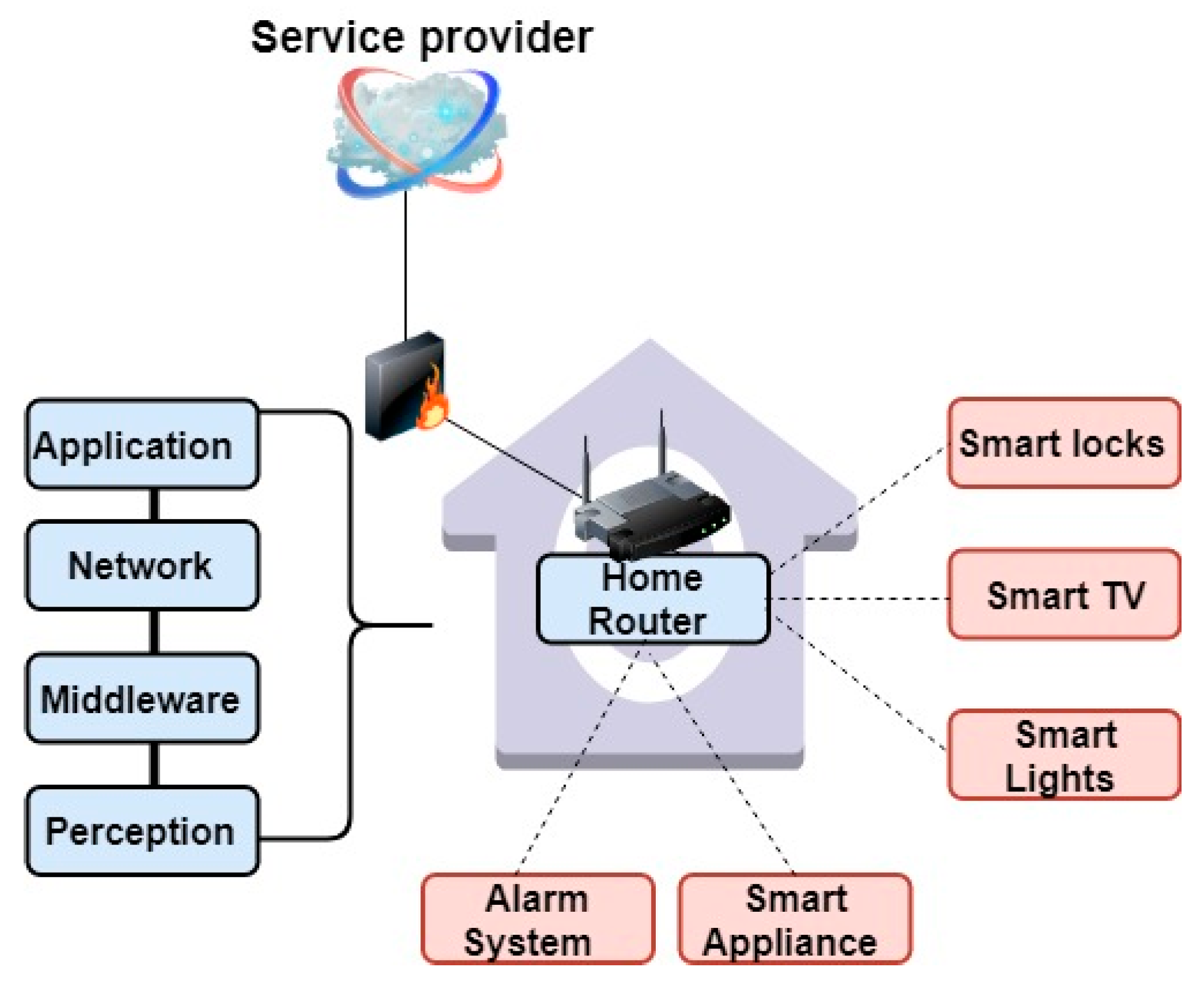
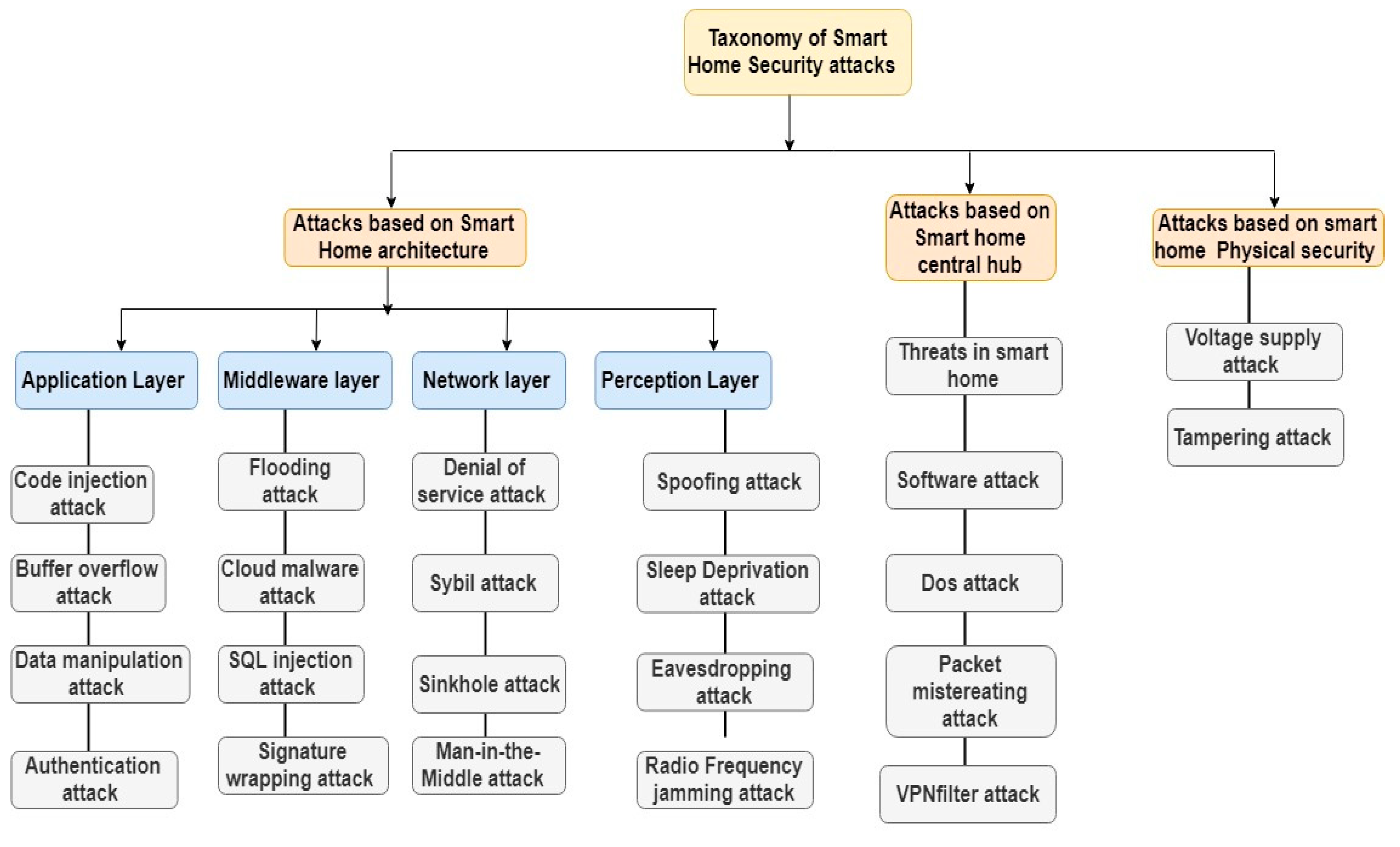
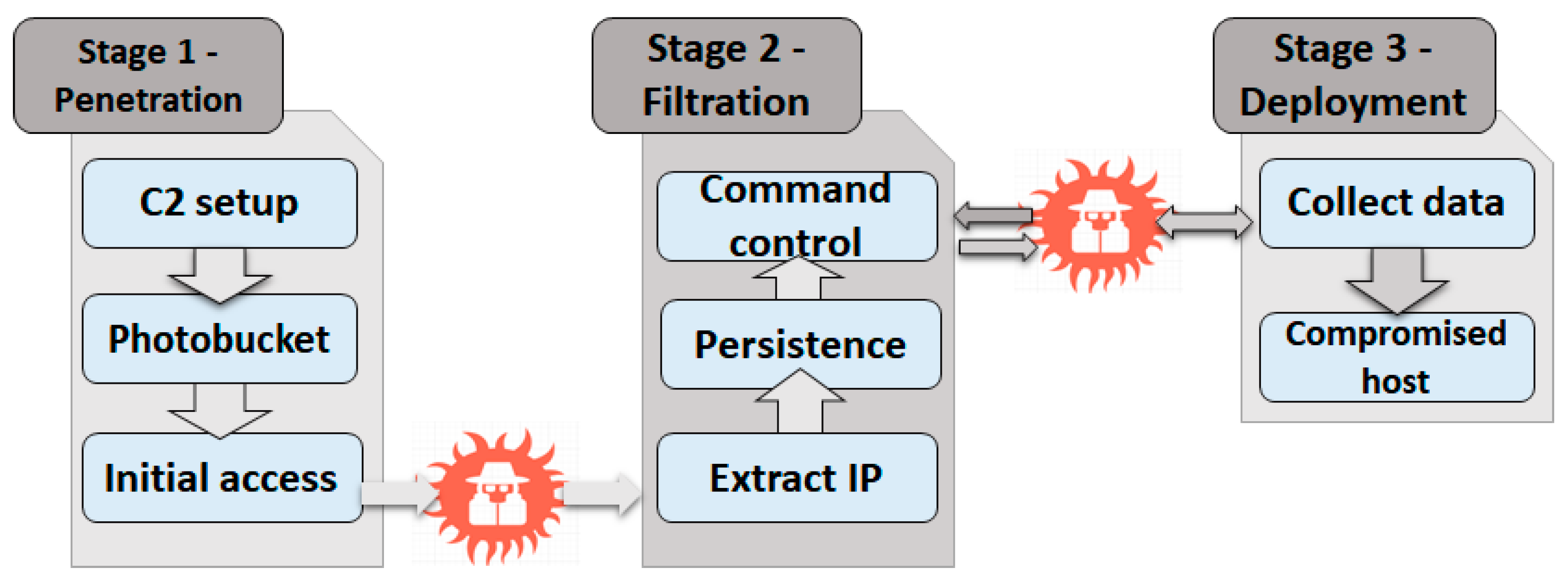
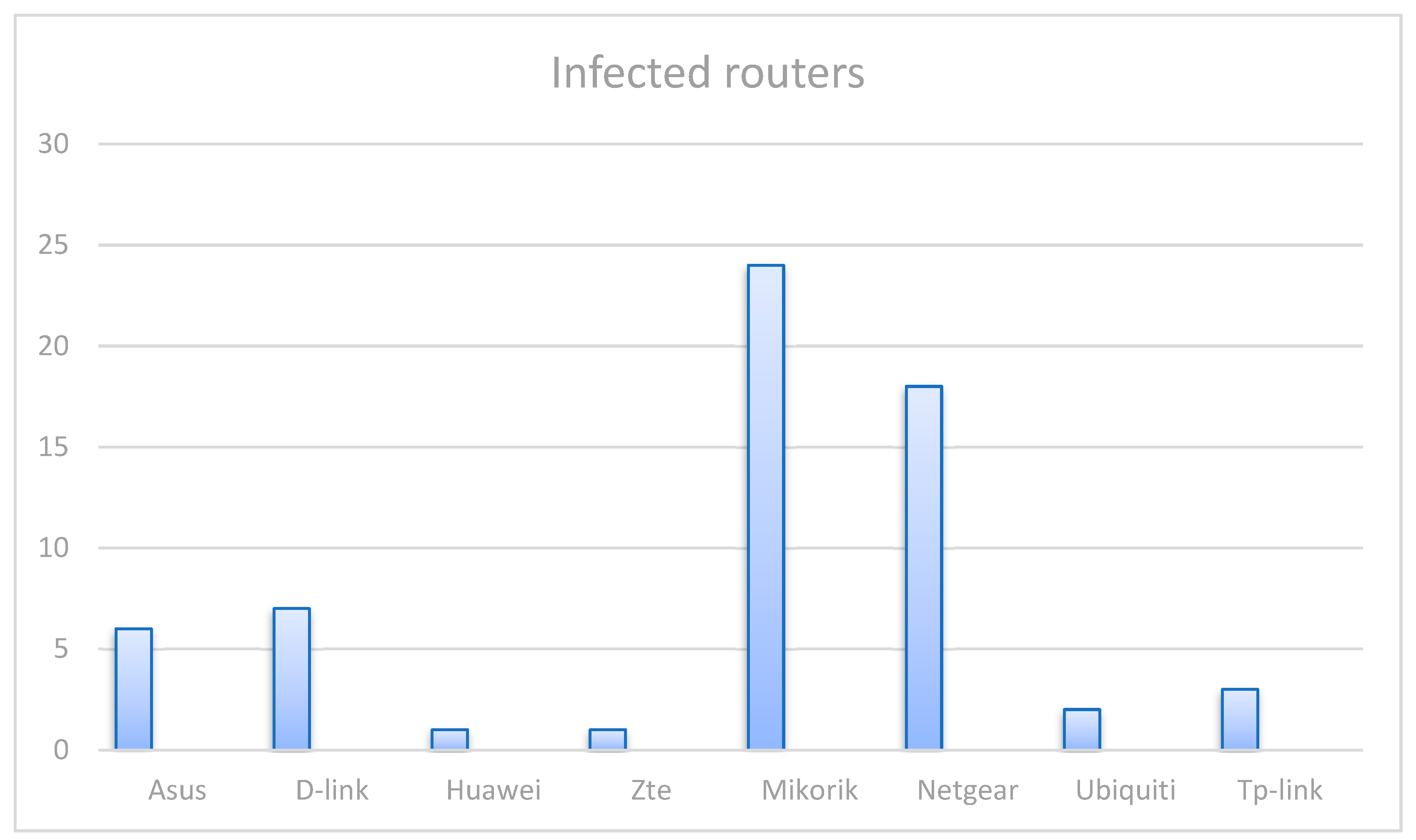
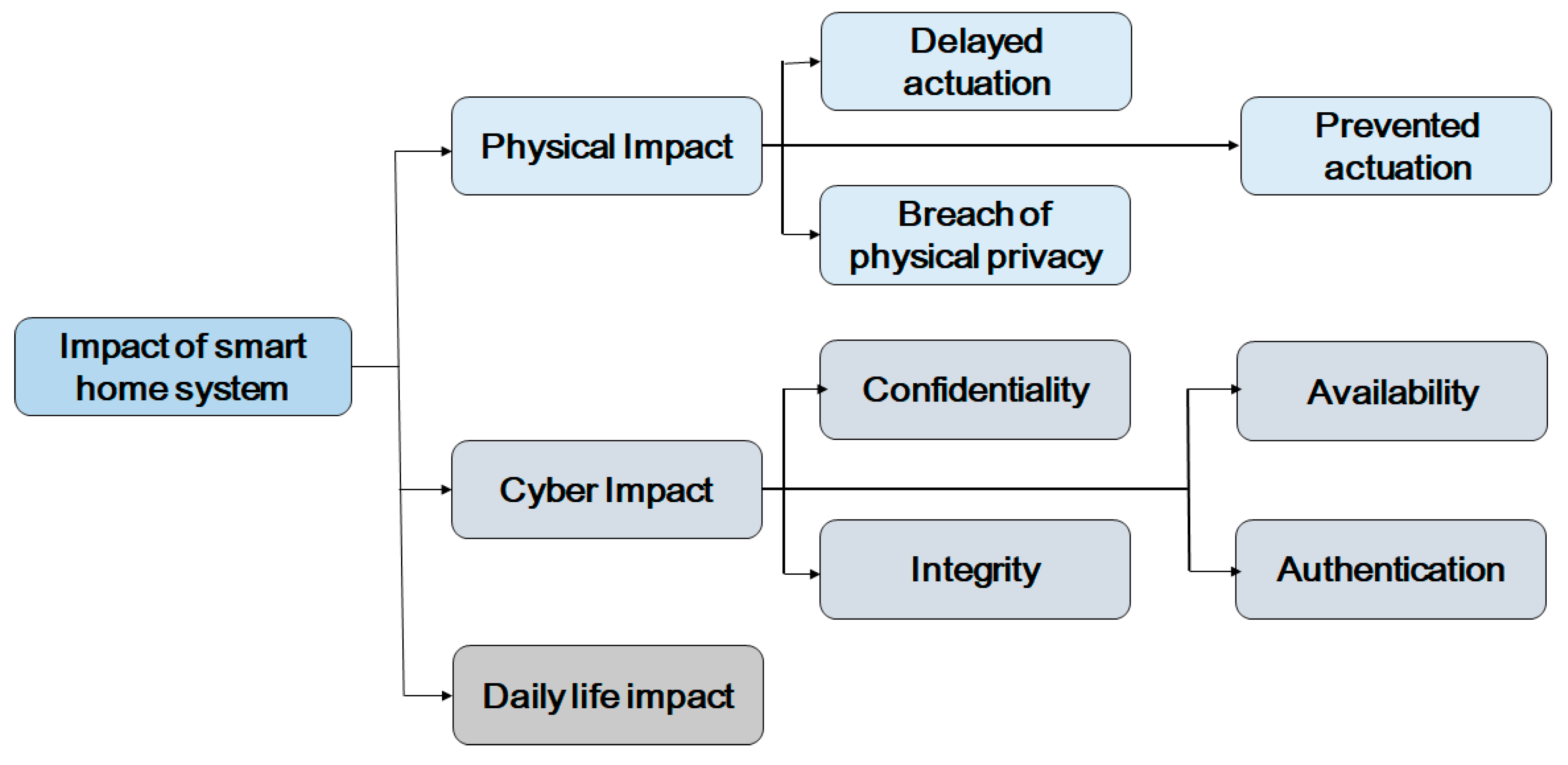
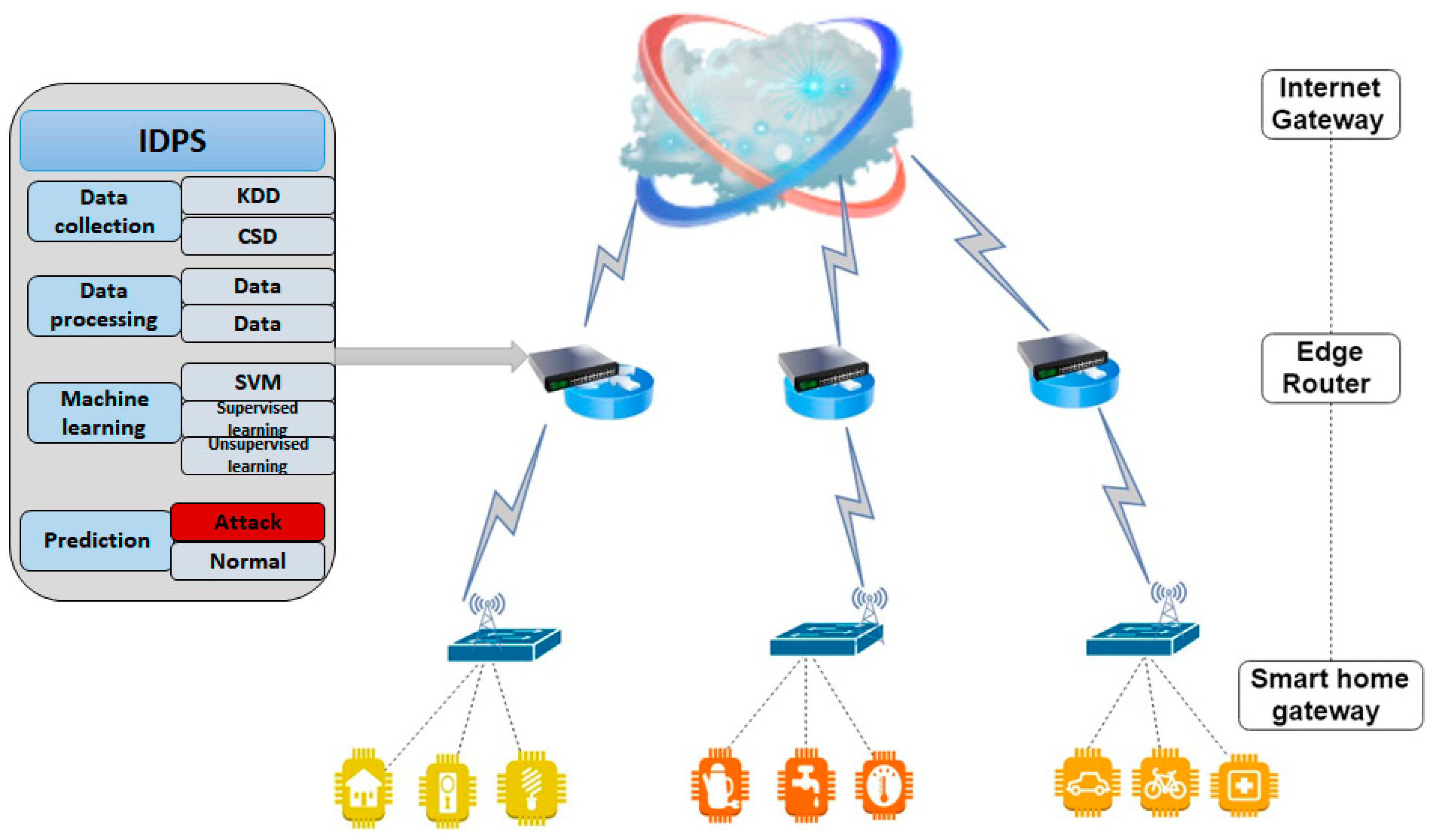
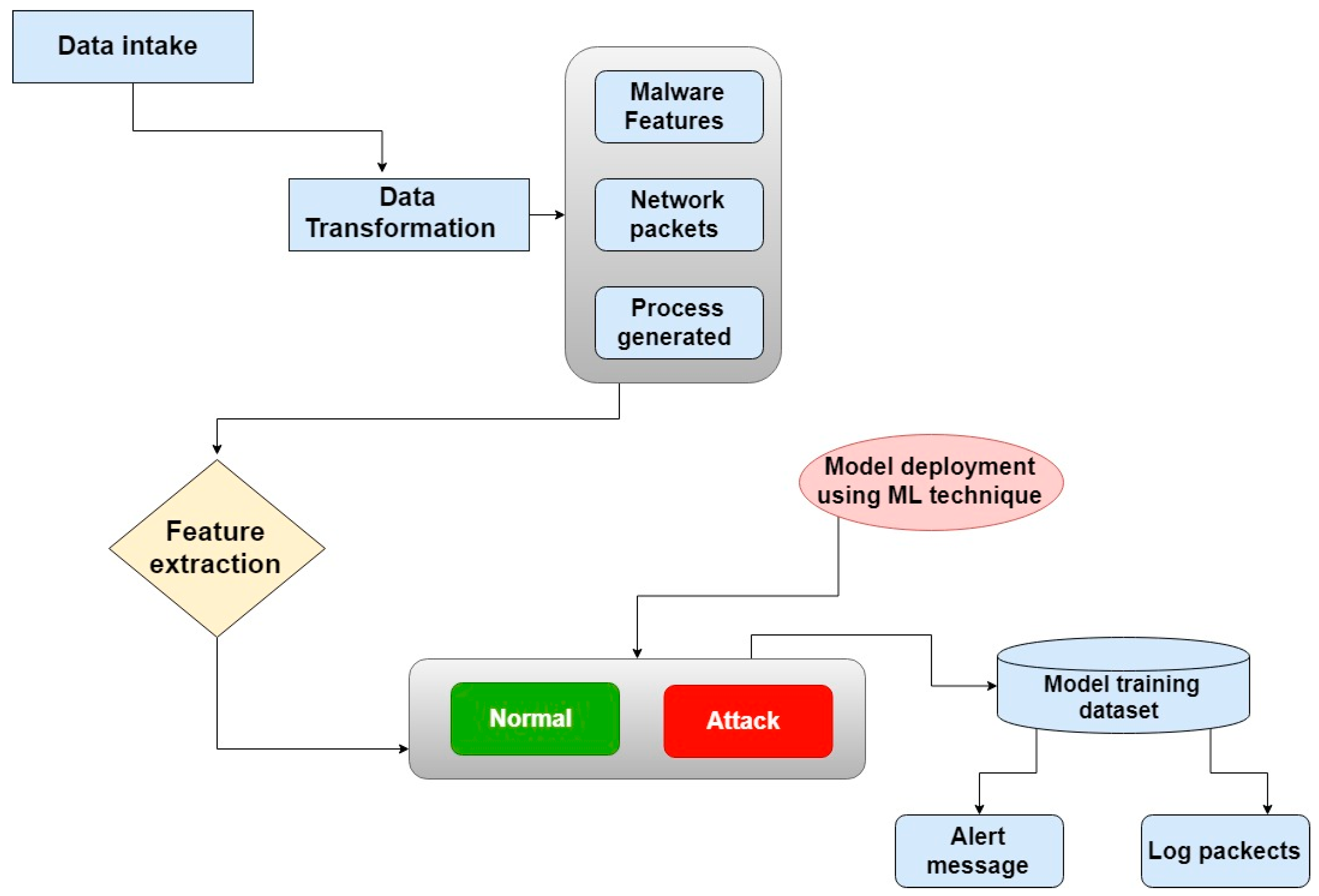
| Research Work | Security Issues | Risk Analysis | Security Solutions | Privacy Issue | Privacy Solutions |
|---|---|---|---|---|---|
| Denning et al. [2] | ✓ | ✓ | |||
| Kirkham et al. [5] | ✓ | ✓ | ✓ | ||
| Babar et al. [6] | ✓ | ✓ | |||
| Lee et al. [7] | ✓ | ✓ | |||
| Notra et al. [8] | ✓ | ✓ | ✓ | ✓ | |
| Arabo et al. [9] | ✓ | ✓ | ✓ | ✓ | |
| This paper | ✓ | ✓ | ✓ | ✓ | ✓ |
| Routers | Asus RT-AC66U [45] | D-link DSR-[44,46] 500N(2) | Huawei HG8245 [47] | Mikroik RB952 [48] | Netgear WNR2000 [49] | Ubiquiti PBE M5 [50] | Tp-link TL-WR741ND [51] | ZTE ZXHN [44,52] H108N | |
|---|---|---|---|---|---|---|---|---|---|
| Features | |||||||||
| Wifi speed | 130 Mbps | 300 Mbps | 54 Mbps | 10/100 Mbps | 300 Mbps | 200 Mbps | 150 Mbps | 300 Mbps | |
| Wi-fi standard | 802.11 ac | 802.11 b/g/n | 802.11 b/g/n | 802.11 b/g/n | 802.11 b/g | 802.11 g/n | 802.11 b/g/n | 802.11 b/g/n | |
| Network mapping | ✓ | ✓ 0 | ✓ | ✓ | ✓ | ✓ | ✓ | ✓ | |
| Easy QoS management | ✓ | ✓ 0 | ✓ | ✓ | ✓ | ✓ | ✓ | ✓ | |
| VPN support | ✓ | ✓ 0 | ✓ | ✓ | ✓ | ✓ | ✓ | ||
| Security vulnerabilities | ✓ | ✓ 0 | ✓ | ✓ | ✓ | ✓ | ✓ | ✓ | |
| Security | WEP, WPA, WPA2, WPS, Radious server | WEP, WPA, WPA2 | WPA-psk, WPA2-psk WPA, WPA2 | WEP, WPA, WPA2 | WEP, WPA, WPA2-enterpise | WPA2-AES | WPA/WPA2 | WEP, WPA/WPA2 | |
| LAN port | 4 | 4 | 4 | 5 | 4 | 4 | 4 | 4 | |
© 2019 by the authors. Licensee MDPI, Basel, Switzerland. This article is an open access article distributed under the terms and conditions of the Creative Commons Attribution (CC BY) license (http://creativecommons.org/licenses/by/4.0/).
Share and Cite
Sapalo Sicato, J.C.; Sharma, P.K.; Loia, V.; Park, J.H. VPNFilter Malware Analysis on Cyber Threat in Smart Home Network. Appl. Sci. 2019, 9, 2763. https://doi.org/10.3390/app9132763
Sapalo Sicato JC, Sharma PK, Loia V, Park JH. VPNFilter Malware Analysis on Cyber Threat in Smart Home Network. Applied Sciences. 2019; 9(13):2763. https://doi.org/10.3390/app9132763
Chicago/Turabian StyleSapalo Sicato, Jose Costa, Pradip Kumar Sharma, Vincenzo Loia, and Jong Hyuk Park. 2019. "VPNFilter Malware Analysis on Cyber Threat in Smart Home Network" Applied Sciences 9, no. 13: 2763. https://doi.org/10.3390/app9132763





